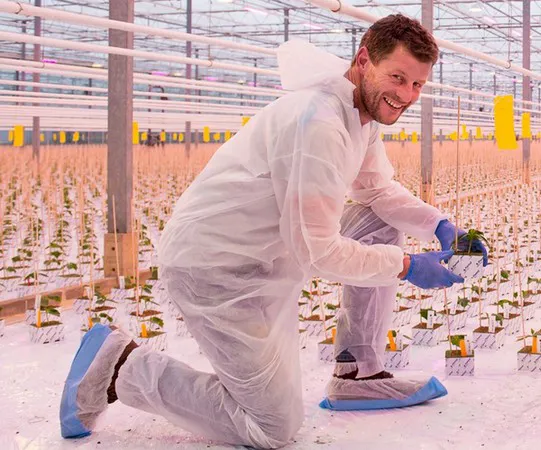September was a beautiful month, but for the propagation of tomatoes, the climate was a challenge. "Moisture levels are tricky and can rise strongly, especially in the early mornings," shared Hans van Herk of Propagation Solutions (below) in a propagation update.

Moisture levels
The planting of lit crops runs until approximately mid-October. Plants pinched on the 2nd leaf, the standard plant type, often have an age of around 53-56 days, so they grow particularly well in September and October. Hans: "These months are characterized by humid mornings, where it can take a long time before the sun is strong enough to evaporate the humidity. This often only happens from 10 o'clock onwards. Furthermore, the radiation is much weaker than in July and August, with maximums of 450-500 watts in north-western Europe. As a result, moisture is pushed out of the greenhouse more slowly and the plants tend to grow vegetatively. This, in turn, can cause poor quality clusters, stretching of the stem (especially with single headers) or more leaves between trusses 1 and 2 on 2nd leaf pinched plants."
Nevertheless, the outside temperature at night still mostly stays above 12 degrees Celsius, so then even more moisture fills the air (= a lower humidity deficit). Hans: "This is also not good for the purpose of propagation of, in this case, a compact plant with lots of energy. If, as in the Benelux, one has to work with black-out screens against light emission, the chance of vegetativeness (elongation, poor quality clusters) is certainly an issue!"

5-6 days before delivery: the goal is a compact plant full of energy with a strong generative touch
Activity
The answer to these propagation problems is activity in the greenhouse climate. This term is comprehensive and easy to interpret, according to Hans. "There are several terms hidden in it, such as ventilation, temperature build-up, plant density, and minimum tube." Hans runs through them below.
Ventilation
It is important to keep the ventilation lines, lea side, and wind side close to the heating line. In the past, the wind side, in particular, was chosen generously, i.e. at 1 degree Celsius or more. This creates a clammy and inactive climate which is not positive for the generative development of the plants. It is better to set the lea side to 0.2 degrees Celsius and the windward windside to 0.5 degrees Celsius so that they react quickly. Controlling with a P-band is not sufficient, this gives a jerky effect on ventilation and therefore on the temperature.
Furthermore, there should be a rain opening on the lea side, to stay as active as possible. It should not rain inside, but often the temperature outside remains the same despite the rain.
Structure in terms of temperature
Climate control is optimal when it is controlled with radiation. When the sun shines, the temperature must rise. A 'boost' in temperature is therefore essential and stimulates the plants enormously. A 'pyramid' shape in terms of temperature over a twenty-four hour period is ideal. The tomato plants are 'put on color' in this way, which means that they develop dark green leaves, lots of bubbles on the leaves (= assimilates), a purple color on the stem, and a truss that is nicely curved; in other words, a generative touch!

Nicely curved cluster just before delivery
Plant density / m2
The final distance for a plant that is about to leave the nursery almost flowering is very low; 4-5 blocks / m2 is quite normal for a pinched plant. Intermediate distances are therefore very sensible, but the best thing to do is to start at a short distance, right from transplanting.
When the plants are transplanted, the blocks are fully saturated. This is necessary in order to realize unhindered growth. However, these blocks also create a very humid microclimate when they are placed next to each other. A solution to this is to place them 1-2 cm apart so that the wind can dissolve the moist micro-climate and the plants remain compact. It is most practical to do this in such a way that the blocks can also be picked up mechanically.
Shortly after pinching, maximally 3-4 days later, the plants must be moved to the next stage. This does not have to be the final distance; intermediate distances are a nice option.
What is important, however, is that the plants are steered to become generative. Too high moisture content remains a threat because the plants themselves are evaporating more and more. A large difference between day and night temperature is necessary, 22-23 degrees Celsius during the day with a minimum of 15 degrees Celsius (depending on the variety). The 24-hour temperature is then often set at 17.5 – 18 C when using a pre-night or a cool morning.
By combining the number of plants/blocks per m2 with a considerable difference in temperature, generative growth is quickly enforced, which strengthens the quality of the clusters. The plants also remain compact, which is certainly also a customer wish. Varieties with larger tomatoes (> 120 grams/fruit) benefit hugely from this, the smaller tomatoes such as cherries often already have this naturally.

A little distance for compactness and a generative touch, time for the next stage
Minimum tube
The minimum tube is, of course, a big energy consumer, but very handy. A tube of 45 degrees Celsius, an hour before sunrise until 2 hours after sunrise with a reduction in radiation, is a fantastic instrument! In propagation, this seems to be inevitable in order to expel moisture. A solution is to 'boost' the minimum tube during the day, which does not cost any extra energy, as the tube temperature is needed anyway to reach the temperature, and the coolness of the morning can be removed at the same time. It will not be much more than 45-50 C. Let it come in slowly (2 hours) but then hold it for 2-3 hours, otherwise, there will be no effect on moisture. Cutting down on light can be done quickly, from 175 watts.
Lighting during propagation (HPS / LED)
Lights at this time of year give the opportunity to raise day length above 12 hours and thus create a long day, Hans continues his update. It also provides extra assimilates so that the plants have plenty of them. "Growers can use these after planting to get speed in the crop. Focussing on clusters is the best method to get a crop in balance."
More and more people are looking at the possibilities with LED in the propagation, Hans knows. "Lit growers often order a plant that is almost flowering or where the first flowers open around the planting date. These are plants with 50 - 60 cm canes that have a lot of leaf area and take up all the square meters in propagation, especially in the last 10 days. This is again vegetativeness. The plants can sort of only grow into the air."
HPS lights have the advantage here that they also bring heat into the greenhouse, Hans points out. "The number of degrees, of course, depends on the concentration. If these lights are switched on late in the evening or at night, they bring in some activity. With LED lighting, this must definitely be compensated by radiation heat from the tubes. This remains the case until the end of the growing period. With a mobile heating system, this can be compensated very well, in order to bring the radiation heat closer to the plants. From an energy point of view this is also attractive!"
According to Hans, it is clear that LED lights provide more energy for plants. "The building up of assimilates is stronger."

Growing tomatoes in a greenhouse with 100% LED (100 micromol)
Irrigation in the nursery
Controlling irrigation is certainly important, as water ensures vegetative growth. As almost all tomatoes are grafted, it is even more important, because the rootstocks benefit strongly from water and nutrients, says Hans. "Control is best when the plants are still small, then dry cultivation with a high EC is important. When the plants are almost ready for delivery, the block volume slowly becomes too small for the large plant and therefore the steerability disappears. In short, you do have to irrigate."
Conclusions
To create a plant that is almost flowering to the growers, the plant propagators have quite a challenge in September and October. They have to pay very close attention to the moisture content in the greenhouse, as Hans explained above. If insufficient activity is created through ventilation, temperature, density, or the minimum tube, problems can easily arise in terms of cluster formation and cluster initiation. But unwanted stem elongation is also problematic for a grower in handling the plant and also makes them difficult to transport. "Lights and irrigation certainly play a role in this as well and need to be well-coordinated," he concludes.
For more information:
Hans van Herk 
Propagation Solutions
+31 (0)6 20 91 81 00
[email protected]
